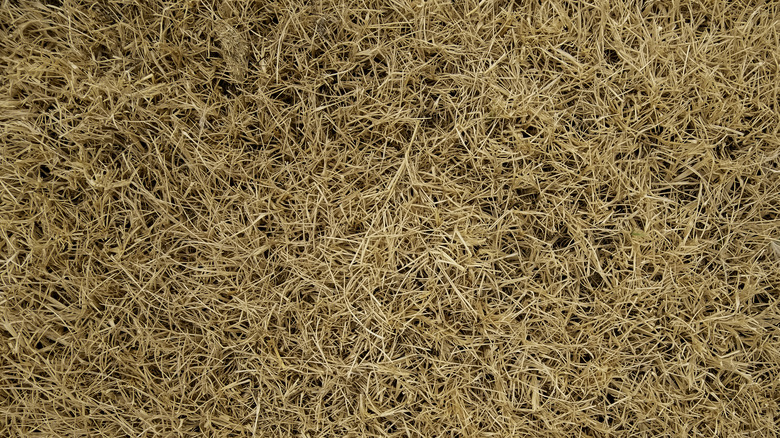Killing Weeds With Vinegar Has A Huge Downside For Your Lawn
Few things are more frustrating than spotting weeds taking over your lawn. They seem to appear overnight, competing with your grass for water, nutrients, and sunlight. It's only natural to want a quick, easy fix, especially when so many commercial herbicides contain harsh chemicals that can harm people and pets. That's why some homeowners turn to vinegar, a pantry staple known for its versatility, as a more natural solution.
Vinegar can kill weeds, but it's not selective. The same acetic acid that wipes out unwanted weeds will damage or destroy any vegetation it touches, including your lawn. On mature grass, household vinegar typically harms only the blades, making homeowners search for the fastest fix for their now yellow lawn. The roots usually survive, and new blades can grow back within about a week. But if your lawn is newly seeded, fewer than three weeks old, vinegar can kill it entirely. Because of that, vinegar is safest for tackling weeds growing in cracks between sidewalks, along driveways, or in other isolated spots. It's much riskier to use on a lawn where spray drift or runoff can hit your desirable grass. Any drift or runoff can hit healthy turf and create dead spots, leaving your grass looking patchy. In many cases, the "quick fix" creates a longer-term repair job.
Why using vinegar to kill weeds will do more harm than good
The reason vinegar is so effective (and so risky) comes down to its acetic acid content. Standard white vinegar contains about 5% acetic acid, which may require several applications to kill tougher weeds. Stronger horticultural vinegars can have 20% or more acetic acid, but even just having a higher acetic acid count of 11% or higher will burn skin and eyes if handled carelessly.
This acid dehydrates weeds, drying out leaves and stems until they can't function. It's most effective on young annual weeds that are only a few weeks old and have shallow roots, while established perennials or mature weeds with deep root systems may survive a single dose and quickly regrow. While reapplication sounds simple enough, each treatment increases the chance of accidentally harming surrounding grass because vinegar will damage anything it touches. Spray bottles, for example, can cause vinegar droplets to drift in the wind or splatter onto your lawn. Once that happens, the affected grass will likely discolor and weaken.
If you do want to use vinegar without killing your good grass, skip the spray bottle and go for a more controlled approach. Dip a small paintbrush or sponge into the vinegar and carefully apply it directly to the leaves and stems of the weed you want to kill. For best results, do this on a sunny, dry day so the weeds dehydrates faster and rain doesn't wash the vinegar into other areas. And if you spill any vinegar onto surrounding grass, quickly flush the area with water to dilute it.
Better natural alternatives to vinegar for killing weeds
Even though vinegar is marketed as a natural weed killer, its downsides make it less than ideal for lawn care. You can try to hand-pull the weeds in your lawn, but that will become time-consuming. If you want a more lawn-friendly, chemical-free method without all the disadvantages of using vinegar in your lawn, preventative mulching is a great option. Laying down a 2-inch layer of mulch (never more than 3 inches deep) blocks sunlight from reaching weed seeds or roots in the soil, preventing them from sprouting. It also helps maintain soil moisture for your desired grass. Water can still pass through, but weeds won't get the light they need to grow.
These methods may take a little more effort up front than grabbing a spray bottle of vinegar or having to pull each weed by hand, but they'll protect your lawn, avoid collateral damage to healthy grass, and give you longer-lasting results. Never fear, though; instead of using vinegar to kill weeds, you can still use it to get rid of gnats once and for all.


